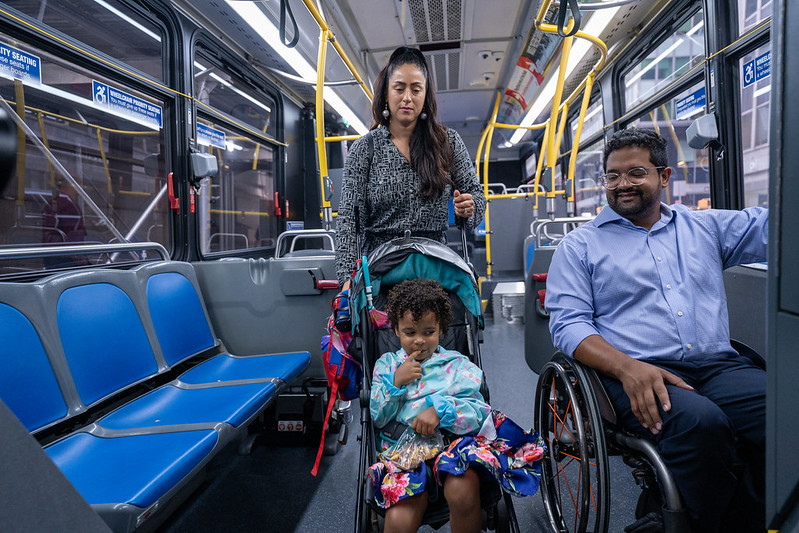New Pilot Creates Designated Space for Open Strollers on 142 Buses Across All Five Boroughs
Pilot Follows MTA Working Group Commissioned Earlier This Year to Improve Customer Experience for Bus Riders with Strollers
View Photos of New Decals
The Metropolitan Transportation Authority (MTA) today announced an open stroller pilot program on buses across all five boroughs. Starting next week, buses on the M31, B1, Bx23, Q50, Q12, S53 and S93 routes will begin to be outfitted with a designated space for one open stroller. By early October, every bus that serves these routes will have a designated stroller space in place.
The buses that are part of the pilot program will be identified with a stroller decal on the outside of the bus that customers can easily see before boarding. Once inside the bus, the designated space will be identified with a similar decal.
“When I arrived at the MTA, I made it clear that my definition of accessibility was a broad one, one that includes parents, children and seniors, as well as riders with disabilities,” said MTA Chief Accessibility Officer and Senior Advisor Quemuel Arroyo. “This pilot program was a direct result of the MTA Accessibility and Bus teams, disability advocates, parents, and bus operators coming together in a collaborative working group to address a concern that customers felt strongly about.”
“When I first arrived, I said we need to try a stroller policy that works for customers, and it can't take years, we need it now,” said NYC Transit President Richard Davey. “This pilot comes at the right time for stroller moms, stroller dads and others who need to bring toddlers onto buses and aligns with our North Star to improve customer satisfaction.”
“We've heard from many parents and caregivers about the difficulty of folding strollers, and how it often deters customers from riding the bus,” said New York City Transit Senior Vice President for Buses Frank Annicaro. “By creating a designated space for one open stroller on these pilot buses, we hope to make the ride easier for caregivers and speed up the bus for everyone by eliminating the need to wait for caregivers to safely fold strollers and get situated on the bus with a child.”
The stroller space will allow customers with young children to board and ride the bus without needing to fold their stroller first. The stroller space will be either an open space near the rear door, or a space created by flipping up two side-by-side seats, depending on the bus model. The designated open stroller spaces are entirely separate from existing priority seating for bus riders with disabilities. A bus rider boarding with a wheelchair will still have the same number of designated spaces.
The pilot is expected to run for six months on the 142 buses that serve these seven routes to gauge ridership. The two seat options -- seat removal versus the flip-up seating space -- will be evaluated to identify the best solution and any potential safety concerns.
The working group that developed the pilot included disability advocates, parents, bus operators and members of the MTA’s Accessibility and Customer Experience teams and NYC Transit’s Department of Buses. The group met throughout the spring and summer and reviewed seating options and stroller policies from other transit systems.
“Babies and their parents deserve a place to travel on the bus, just like everyone else,” said Jessica Murray, Ph.D., Chair of the MTA’s Advisory Committee on Transit Accessibility (ACTA) and Working Group Member. “Working together, bus operators, parents, and disabled riders were able to hear each other's perspectives. I'm proud of the efforts of all involved in the working group to find possible solutions to this longstanding problem.”
“Caregivers who use strollers, many of whom rely on transit to get around our city with their children, have been heard,” said Christine Serdjenian Yearwood, UP-STAND Founder & CEO, ACTA member, and Working Group Member. “Our stroller working group has been enthusiastic about taking real action steps to move accessibility forward in a way that has been collaborative and thoughtful. We went through a lot of discussion and testing with a diverse group of stakeholders, and we are confident that this pilot will be very informative and help us continue to make progress on this issue.”
"I was excited to be part of the stroller working group with some great advocates and some of the best in the business when it comes to MTA bus operators," said Dustin Jones, President & Founder of United for Equal Access NY Inc and Working Group Member "I think everybody deserves a seat at the table, or in this case on the bus, including caregivers looking for a way to be comfortable riding the bus with their young ones."
“We thank the MTA for listening to us, taking action and making parents like me feel like valued customers,” said Danielle Avissar, Parent Advocate and Working Group Member. “There is a parent behind me, one behind them and behind them, who want to ride the bus and will benefit from this change.”
"Public buses should be welcoming and inclusive of all New Yorkers and visitors to our city," said Riders Alliance Executive Director Betsy Plum. "Riders are confident that the MTA, with the input of multiple stakeholders–riders, caregivers, disability advocates, and bus operators–has found an initial path forward for a safe and efficient way to fit caregivers and strollers on buses alongside other riders, critically those who use wheelchairs. We are looking forward to the pilot program launching and the opportunity to learn more about strollers on buses in real time. More than anything, we are energized for the start of something big that boosts bus ridership and extends convenient and affordable transit to even more New Yorkers."
For buses not participating in the pilot, the current stroller policy will remain in effect. For more information on the pilot, visit the program’s dedicated webpage.
